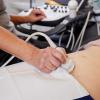The majority of pregnancies are problem-free. Fortunately, most children come into the world in perfect health. Screenings during pregnancy and shortly after birth can identify any complications, diseases or disorders at an early stage, whereupon treatment can be offered. A screening during pregnancy is termed ‘prenatal’; that after birth is termed ‘postnatal’ and together they are known as ‘perinatal’ screenings.
Screening during pregnancy
Prenatal Screening for Infectious Diseases and Erythrocyte Immunisation (PSIE)
The aim of the PSIE test (a blood test for pregnant women) is to prevent hepatitis B and HIV carrier status, congenital syphilis and haemolytic disorder in the foetus and/or neonate.
Every pregnant woman is offered a blood test on her first visit to the obstetrician. The laboratory then tests the blood for the presence of three infectious diseases (hepatitis B, syphilis and HIV), for the ABO blood groups, rhesus D and rhesus C, and for blood group antibodies. After the first blood sample, various follow-up actions may be initiated within the screening programme if the results of the blood tests give reason to do so. More information: Prenatal Screening for Infectious Diseases and Erythrocyte Immunisation (PSIE).
Prenatal screening for Down’s, Edwards’ and Patau’s syndromes
The aim of the screening for Down syndrome is to inform people who want to have this information in good time of the presence or absence of the disorder in question so that they can make a well-informed decision about further options.
Prospective parents who wish to do so can arrange for a test during the pregnancy to show the likelihood that their baby has Down’s, Edwards’ or Patau’s syndrome. This is done through what is known as a ‘combined test’, comprising a blood test between weeks 9 and 14 and an ultrasound scan between weeks 11 and 14 of the pregnancy. In the screening for Down syndrome (trisomy 21), information is also given on the likelihood of trisomy 13 (Patau's syndrome) and trisomy 18 (Edwards' syndrome). This is followed by a counselling talk with the provider of obstetric care if the pregnant woman indicates that she would like to know more about the screening. More information: Prenatal screening for Down’s, Edwards’ and Patau’s syndromes.
You can download leaflets about the Prenatal screening for Down’s, Edwards’ and Patau’s syndromes in five languages.
The 13-week scan and the 20-week scan
The aim of the 13-week scan and the 20-week scan is to inform people who wish to have this information on time of the presence or absence of physical abnormalities so that they can make a well-informed decision about further options. A physical abnormality means that part of the baby’s body looks different from what is expected. Examples of physical abnormalities are spina bifida (an open spine), an open skull, hydrocephalus, heart defects, a hole in the diaphragm, a hole in the abdomen, structural abnormalities of the kidneys, and structural abnormalities of the bones.
The 13-week scan can be performed from twelve weeks and three days up to and including fourteen weeks and three days of pregnancy. The 20-week scan can be performed from week 18 up to and including 21 weeks and zero days of pregnancy.
In the Netherlands, you can only opt to have the 13-week scan if you are participating in the scientific IMITAS study. This study is investigating the advantages and disadvantages of the 13-week scan.
You can download leaflets about the 13-week scan and the 20-week scan in five languages.
Screening after the birth
Neonatal blood spot screening
The aim of neonatal blood spot screening is to detect in good time a number of rare severe disorders that affect neonates in order to prevent or limit severe damage to the baby’s physical and mental development. The disorders cannot be cured, but they can be treated.
A blood spot test is offered for all babies between 72 and 168 hours after birth. The baby’s blood is screened for a number of rare, severe disorders. Most are hereditary. In the event of an abnormal result, the baby will be referred to a university hospital or general hospital, where a definite diagnosis will be made and treatment will be started. More information; Neonatal blood spot screening.
You can download leaflets about Neonatal blood spot screening in ten languages
Neonatal blood spot screening for the Caribbean Netherlands
At present, prenatal and neonatal screening is only carried out in the European Netherlands. Since 2010, the islands of Bonaire, Sint Eustatius and Saba – collectively known as the Caribbean Netherlands – have been special municipalities within the Netherlands. This means that the Dutch Minister of Health, Welfare and Sport is responsible for healthcare in the Caribbean part of the Netherlands. As of 1 January 2015, blood spot screening has also been carried out on the islands of Bonaire, Sint Eustatius and Saba.
Neonatal hearing screening
The aim of neonatal hearing screening is to detect hearing loss as soon as possible so that treatment can start before the baby is six months old. Evidence shows that this has a beneficial effect on language and speech development.
The hearing test should in principle be performed as soon as possible after the first 96 hours, and certainly no later than 168 hours after the birth. In the event of an abnormal result for one or both ears, the hearing test can be repeated twice if required. If the result remains abnormal, this is followed by referral to an audiology centre for further diagnostic tests and treatment as necessary. The hearing test is usually offered in combination with the blood spot test.
The neonatal hearing screening is part of the basic care package in youth healthcare services. The said basic care package in youth healthcare services is based on the Public Health Act and is determined by the Ministry of Health, Welfare and Sport. The neonatal hearing screening test differs in a number of respects from the other prenatal and neonatal screening tests described in this policy framework.
For example, the Health Council of the Netherlands does not play a role in the hearing screening, no reference function has been set up and there is no regional coordinating organisation for neonatal hearing screening of the kind described further on in this document. More information; Neonatal hearing screening.
You can download leaflets about Neonatal hearing screening in ten languages.
What RIVM does
Perinatal screenings form part of the national population screening programme. RIVM is responsible for their coordination and direction. RIVM must ensure that all parties within the chain play their role as effectively as possible, with appropriate communication. We therefore produce guidelines, national agreements, intervention plans and information for both professionals and the general public.
At the regional level, the PSIE and heel prick are administered by the RIVM Regional Programme Coordination office. Other screening programmes are managed by external organisations. The population screenings are actually conducted by a chain of professionals and organizations who work closely together: midwives and obstetricians, echoscopists, gynaecologists, the Prenatal Screening Centres, youth health services and laboratories.




